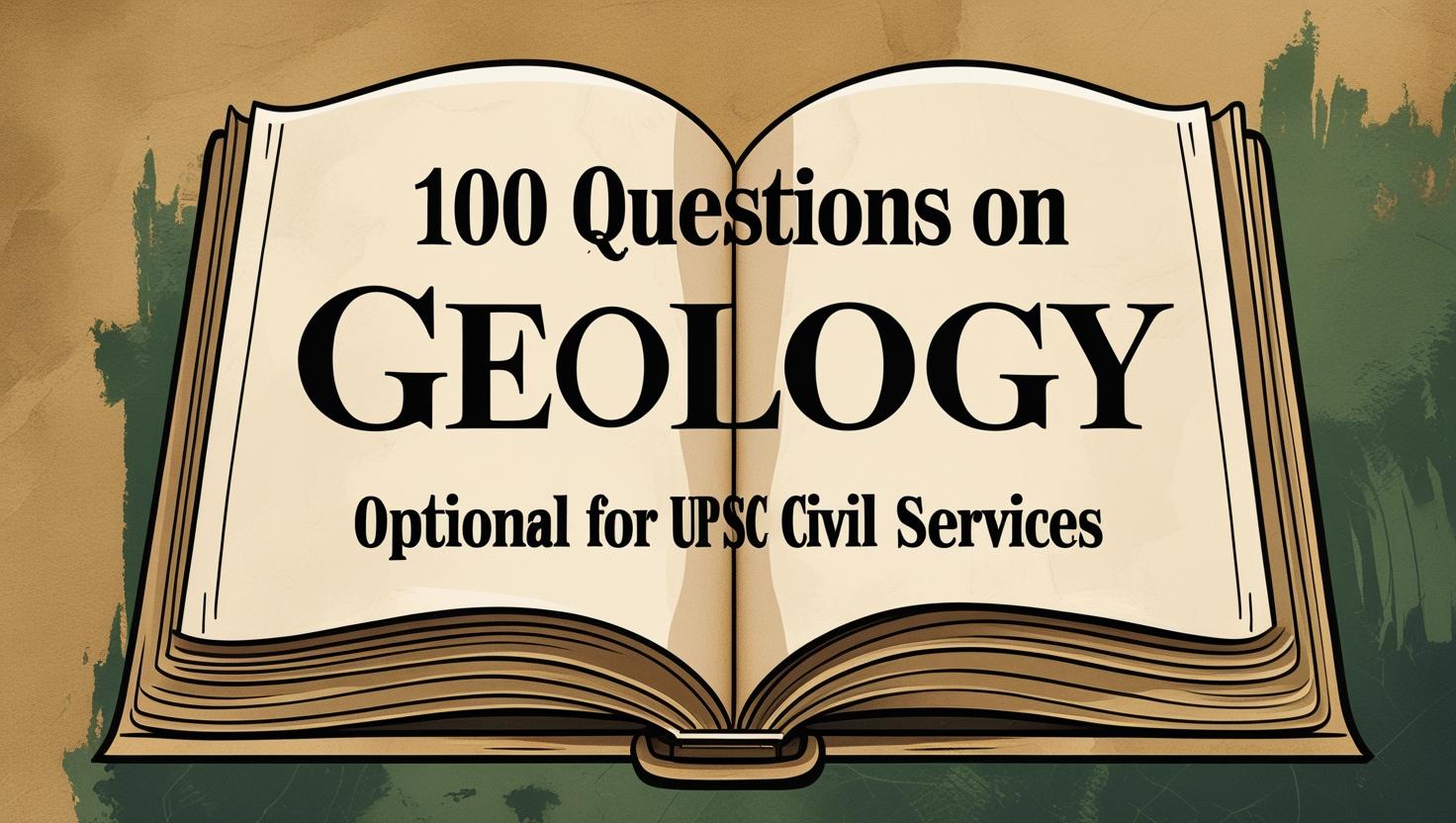Introduction
Geology is a popular optional subject in UPSC Civil Services, chosen for its scientific approach, precise concepts, and interdisciplinary applications. To aid aspirants in systematic preparation, here is a compilation of 100 important practice questions divided chapter-wise according to the UPSC Geology syllabus. These questions cover fundamental and applied aspects of geology, ensuring comprehensive coverage for both Paper I and Paper II.
For UPSC Coaching , Join FIRST IAS INSTITUTE (India’s Top IAS Coaching)
Chapter 1: General Geology
- Explain the internal structure of the Earth and its significance in geological processes.
- Discuss the origin and age of the Earth with reference to radiometric dating methods.
- What are plate tectonics? Explain their role in mountain building.
- Differentiate between continental drift and seafloor spreading.
- Explain the distribution and mechanism of earthquakes.
- Write a note on seismic belts of the world.
- Discuss the types of volcanoes and their distribution across the globe.
- Explain the concept of isostasy with relevant models.
- What are geosynclines? Discuss their role in the formation of mountain ranges.
- Describe the geological time scale and its subdivisions.
Chapter 2: Geomorphology
- Discuss the processes of weathering and their types.
- Explain the cycle of erosion by Davis.
- Describe the geomorphological features formed by fluvial processes.
- Explain the geomorphology of arid regions.
- Write a note on glacial landforms.
- Explain the features of coastal landforms.
- Describe the landforms associated with wind action.
- Discuss the significance of geomorphology in environmental studies.
- Explain the concept of peneplanation.
- What is mass wasting? Discuss its types and impact.

3: Structural Geology
- Explain the mechanics of folding and classify folds.
- What are faults? Explain their types with suitable diagrams.
- Discuss the classification and formation of joints.
- Explain the concept of stress and strain in rocks.
- Describe unconformities and their significance in geology.
- Write a note on structural traps for petroleum.
- Explain the concept of lineation and foliation in rocks.
- Discuss the classification of mountains based on structural features.
- Explain the concept of shear zones and their importance.
- Differentiate between brittle and ductile deformation.
Chapter 4: Paleontology
- Explain the process of fossilization and its types.
- What are index fossils? Discuss their significance.
- Describe the morphology and geological history of trilobites.
- Write a note on brachiopods and their geological importance.
- Discuss the evolutionary history of cephalopods.
- Explain the significance of microfossils in petroleum exploration.
- Describe the evolution of amphibians.
- Discuss the evolution of reptiles with reference to dinosaurs.
- Explain the origin and evolution of mammals.
- Write a note on Gondwana flora and its significance.
Chapter 5: Stratigraphy
- Discuss the principles of stratigraphy.
- Write a note on lithostratigraphy and biostratigraphy.
- Explain the concept of facies and its significance.
- Discuss the major stratigraphic divisions of India.
- Write a note on the Cuddapah Supergroup.
- Describe the Vindhyan Supergroup and its significance.
- Explain the Gondwana system of India.
- Write a note on the Deccan Traps.
- Discuss the Siwalik Group and its geological significance.
- Explain the concept of sequence stratigraphy.
6: Mineralogy
- Explain the physical properties of minerals used in identification.
- Discuss the classification of silicate minerals.
- Describe the structure of feldspar group of minerals.
- Write a note on quartz and its varieties.
- Explain the optical properties of minerals under polarised light.
- Describe the isomorphism and polymorphism in minerals.
- Explain the classification of crystal systems.
- Discuss the significance of X-ray diffraction in mineralogy.
- Write a note on ore minerals of iron.
- Discuss the mineralogical characteristics of clay minerals.
Chapter 7: Petrology
- Explain the classification of igneous rocks.
- Describe the structures and textures of igneous rocks.
- Discuss the classification of sedimentary rocks.
- Write a note on the structures of sedimentary rocks.
- Explain the classification of metamorphic rocks.
- Discuss the types of metamorphism.
- Write a note on migmatites.
- Explain the concept of metamorphic facies.
- Discuss the origin of basalt and granite.
- Write a note on ultramafic rocks.

Chapter 8: Economic Geology
- Explain the processes of ore formation.
- Discuss the classification of ore deposits.
- Write a note on magmatic ore deposits.
- Explain hydrothermal ore deposits with examples.
- Describe placer deposits and their significance.
- Write a note on coal deposits of India.
- Discuss the occurrence and distribution of petroleum in India.
- Explain the occurrence of natural gas in India.
- Write a note on atomic minerals of India.
- Discuss the role of geological studies in mineral exploration.
9: Applied Geology
- Explain the role of geology in groundwater exploration.
- Discuss the methods of groundwater exploration.
- Write a note on watershed management.
- Explain the role of geology in dam site selection.
- Discuss the geological considerations in tunneling.
- Explain the role of geology in building construction.
- Write a note on natural hazards and their mitigation.
- Discuss the application of remote sensing in geology.
- Explain the use of GIS in geological studies.
- Write a note on environmental geology.
Chapter 10: Indian Geology
- Discuss the geological evolution of the Indian subcontinent.
- Explain the Precambrian geology of India.
- Write a note on the Dharwar system.
- Discuss the Tertiary formations of India.
- Explain the Quaternary deposits of India.
- Describe the Himalayan tectonics and its evolution.
- Write a note on the Indo-Gangetic plains.
- Discuss the marine geology of India.
- Explain the mineral resources of the Indian shield.
- Write a note on the petroleum basins of India.
Conclusion
Geology optional in UPSC demands conceptual clarity, diagrammatic precision, and applied understanding. The above 100 questions, divided into chapters, provide comprehensive coverage for practice and revision. Regular answer writing and integration of maps and diagrams will help aspirants maximize their scores and enhance their chances of success in the Civil Services Examination.
Also Visit – Best IAS Coaching in India
For Answer Writing Techniques – Join FIRST IAS INSTITUTE

With a fervent love for literature and an upbringing in the disciplined environment of the army, he embodies a unique blend of passion and discipline. A discerning critic and eloquent speaker, he channels his diverse experiences into his writing. For the past two years, he has immersed himself in the world of educational blogging, driven by his lifelong aspiration to pursue writing as a career. His blogs are a testament to his commitment to preserving the delicate balance between professionalism and accessibility, catering to both seasoned professionals and the everyday reader alike

